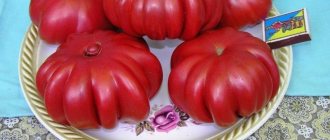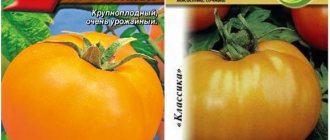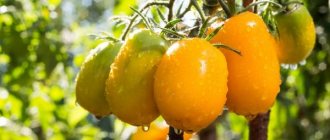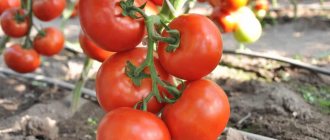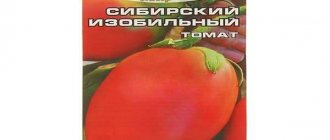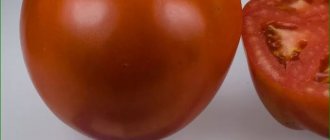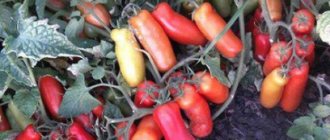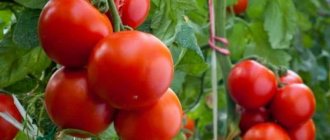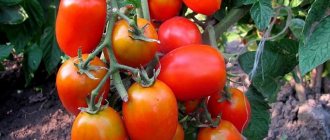Yellow tomatoes are no less popular than red and pink ones. They are consumed fresh, preserved for the winter and processed into ketchups of unusual colors. Therefore, most gardeners grow tomatoes in sunny shades on their plots.
There are a large number of varieties and hybrids of yellow tomatoes. Among them, farmers try to choose those that have a pleasant taste and immunity to diseases. Among them, the Lemon Giant tomato stands out with fruits of the size corresponding to the name.
History of creation
The originators of the Lemon Giant set themselves the goal of creating a variety that does not contain carotenoids. The absence of this pigment makes tomatoes yellow. This is very important for allergy sufferers, because red pigment often causes allergies. People with a reaction to regular tomatoes can safely eat yellow-fruited varieties.
The work was carried out on the basis of the Scientific and Production Corporation of Shchelkovo. The variety turned out to be successful, was highly praised by specialists in the field of breeding, and already in 2000 it was included in the official State Register of Breeding Achievements of Russia. Now many agricultural firms are engaged in seed production, because seed material is constantly in demand.
Related article:
What fertilizers do tomatoes lack?
Positive and negative sides
Giant lemon tomatoes have a fairly large number of positive qualities. The main advantages are considered to be:
- the fruits have high taste;
- high level of productivity;
- giant Lemon tolerates transportation well and can be stored at home for a long time;
- high content of vitamins and amino acids;
- are not exposed to disease.
The variety has high productivity
The main disadvantages of the variety include the fact that this type of plant requires regular feeding and high-quality watering. If you do not comply with all these requirements, the fruit will become filled with water and the yield will decrease.
Description
Lemon giant is a large-fruited mid-season variety. This is a variety, not a hybrid, so it is not so capricious, and its seeds can be used for propagation. At the same time, all varietal characteristics will be preserved in the next generation.
The plant is classified as indeterminate, that is, it has unlimited growth. At the same time, the bush is branched and powerful. It will not stand under its own weight, and during cultivation it is necessary to tie it to supports, timely pinching and shaping. If growth is not limited, then with good care the plant grows up to 2.5 m per season. At first, the growth rate is very high, and towards the end of the growing season it slows down a little.
The tomatoes are collected in clusters of 4-6 pieces, they are round in shape, very large, with slight ribbing. Inside the seed chambers there are large seeds, quite a lot of them.
The main characteristic feature is its bright lemon color, thanks to which the plant looks very decorative in the beds. The pulp is dense, fleshy, but not dry. The taste is rich, with a pleasant sourness, which emphasizes the unusualness of the tomato. The peel is thin, but quite durable. It does not crack even when the fruit is overripe.
Related article:
Tomato Chio-chio-san F1 – description of the popular variety, characteristics and reviews
The variety is very useful in terms of nutritional characteristics. The fruits are rich in beta-carotene and ascorbic acid. At the same time, the amount of lycopenes is reduced to zero, so the likelihood of allergies is practically absent.
Interesting! Secrets of growing tomatoes from experienced gardeners
Fruits of the Lemon Giant variety
The bush produces 4-5 clusters with ovaries, in which 3-5 fairly large round or heart-shaped tomatoes are formed. The average “lemon” weighs 400-500 g, but individual fruits exceed the average and grow up to 700-800 g. They are usually formed on the lower branches.
The tomato skin is firm but not rough. It reliably protects the berry from cracking during ripening, but is practically not felt when eating a fresh vegetable. The color of the skin – bright yellow, glossy – makes it look like a large lemon. At technical ripeness, tomatoes are green, with a darker base. Transportability is high. Tomatoes do not lose their presentation for several days, even during long-distance transportation.
The pulp contains a large amount of dry matter and has an excellent taste and aroma. The characteristics and descriptions of the variety given by those gardeners who planted it also note the increased sugar content of the berries. The lemon tomato does not have a sour taste, but when grown in cold seasons it can be slightly watery and tasteless.
The light, almost uncolored pulp contains vitamins, proteins and lycopene, not inferior to red varieties. But due to the reduced acidity of the juice and the hypoallergenic nature of the lightly colored pulp, the Lemon Giant variety is considered useful for people who are prescribed dietary nutrition. The structure of the pulp resembles a ripe melon: tender and pleasant.
Like most modern large-fruited varieties, Lemon Giant is classified as a variety of beef tomatoes. It has few seed chambers; they are almost invisible in the fleshy core of the fruit.
Salad variety. Lemon giants are delicious in fresh salads, look beautiful in holiday slices, and can be used as a base for gourmet snacks or as slices for sandwiches. The tomato flavor and uncolored pulp are suitable for light sauces that require such flavor.
Tomatoes can be processed into juices and purees for unusual light-colored sauces. Children really like non-traditional products and will be useful for dietary nutrition. You can preserve tomatoes only in the form of snacks or salads, cutting them into slices.
Characteristics
Before deciding to grow this tomato, you need to familiarize yourself with its main characteristics:
- Region – all regions of Russia.
- Type of cultivation - in closed ground, under film or open method in beds. Depends on the farming zone.
- General description – mid-season tomato of Russian selection without red pigment.
- Height – up to 2.5 m.
- Fruit ripening time is 105-110 days from the moment of sowing (4 months).
- The average weight of a tomato is 700 g.
- Difficulty to grow - relatively undemanding.
- The main points during cultivation are fertilization and watering.
- Resistance to infection by infectious diseases is high.
- Transportability is good.
- The appearance of the fruit is excellent, the tomatoes are even, deformation is extremely rare.
Related article:
Tomato Red Rooster - characteristics and description of an early variety
All these characteristics have made the Lemon Giant variety in demand both on an industrial scale and among amateurs.
Caring for adult tomatoes
Regardless of where large-fruited tall “Lemon Giant” tomatoes are grown, they require shaping, gartering and pinching.
Plants are formed into 1-2 stems. For open ground, the formation of 2 stems is suitable; in greenhouses, it is better to form one. This helps avoid crowding of tall plants. The lower leaves and side shoots are removed.
It is necessary to tie up plants. The large-fruited, tall variety "Lemon Giant" is famous for its yield, so the stems need help in holding the clusters.
Fertilizing for tall, large-fruited varieties is necessary. It is necessary to apply complex mineral fertilizers three times during the growing season. Nitrogen components can be introduced with organic compounds, potassium - with the help of wood ash. Additionally, the bushes are sprayed on the leaves with a complex of microelements.
Pinching is another agrotechnical nuance for those who want to get very large fruits. It allows you to regulate the yield of large-fruited tall tomatoes of the Lemon Giant variety. After the third cluster, the shoot is pinched, and no more than 2 fruits are left in the cluster. In this case, the tomatoes grow to gigantic sizes.
Watering is plentiful, but not frequent. Take warm water and water it in the evening.
Area of application of fruits
The characteristics of the pulp, such as the absence of red pigment and the high content of vitamin C, have made the lemon giant one of the elements of dietary nutrition. The variety is recommended in the diet of allergy sufferers and for certain diseases of the gastrointestinal tract.
The variety is developed primarily for fresh consumption. Tomatoes are used in salads or as fresh cut vegetables. Tomatoes make very tasty tomato paste and juice, but these products have an unusual color, so they make preparations of this kind only to reduce the risk of allergies.
Related article:
Calendar for planting tomatoes for seedlings 2021. Favorable days in February and March
Since the fruits are very large, it is inconvenient to use them for pickling or pickling. But the variety is successfully added to stews, stuffed, dried and frozen as part of vegetable mixtures.
Harvesting and application
The ripeness of tomatoes is indicated by the bright yellow color of their shell. The first ripe fruits are harvested at the end of July.
Ripe tomatoes are torn off along with the stalk. This will increase their shelf life.
In cloudy weather, it is better to collect unripe large fruits. This will reduce the likelihood of plants becoming infected with late blight. Green tomatoes will ripen at home.
Lemon giant is a universal variety. It is eaten raw, used for preparing hot dishes and canning.
Diseases and pests
The characteristics of the variety contain information that the tomato is genetically resistant to most specific diseases. Viruses and fungi such as tobacco mosaic, verticellosis and fusarium do affect the lemon giant with less intensity than other varieties. This does not mean that these diseases cannot appear, but they occur earlier, and when they do occur, their spread is easier to control with drugs.
To prevent this, preventive measures are very important: calcining the soil for sowing seeds, preparing the soil in the greenhouse by etching a solution of manganese or copper sulfate. This will not only stop the development of bacteria, but also destroy the parasite larvae.
Related article:
If the tips of the leaves dry out on tomato seedlings
When growing, it is important to carry out preventive spraying. Eco-farms give preference to biological preparations, while other farmers prefer chemical ones.
A problem may arise with insects that attack this crop. Insecticides can be applied before the buds bloom. After flowering and the appearance of the ovary at a low planting density, it is better to switch to infusions of celandine, yarrow, etc.
Features of agricultural technology
“Lemon giant” has its own characteristics. The tomato is prone to fattening, so it cannot be grown using the classical technology. To get a harvest on time and of excellent quality, all points of technology must be taken into account. Features take place in:
- seedling period;
- selection of fertilizers for feeding.
Seedling period
Having purchased seeds once, you can use your planting material for years in the future, since the variety perfectly transmits genetic information.
The variety has an average ripening period and you cannot delay sowing. The best time for sowing is the beginning of March, with the obligatory soaking of the seeds. By warming up and germinating the seed, you can gain 1-1.5 weeks and get the harvest earlier.
Seed preparation
For the seed to show signs of life, it should be wrapped in a damp cloth or filter paper and placed in a plastic bag in a warm place.
After 3-4 days, signs of germination (white root) will indicate the time of sowing. Do not allow it to overgrow and cause green shoots to appear.
Soil preparation
Since growing the variety has its own characteristics, and they relate to preventing fattening of the tomato, the soil must be prepared especially carefully.
The soil mixture should be prepared as follows:
- humus of animal origin (certainly well-ripened);
- compost;
- garden soil.
Taking all the ingredients in a third of the bucket, add 1 kg of sand and 2 tbsp. spoons of superphosphate and ammonium nitrate.
It should be taken into account that the variety does not accept ammonia fertilizing; it begins to fatten. Therefore, nitrogen is applicable only during the seedling period.
The components are mixed well and kept without freezing for 2-3 weeks.
Sowing
You can sow the seeds in one tub, and then plant them in individual cups.
Sowing is carried out as follows:
- Fill the container with soil mixture and compact it;
- We spread the living seeds (sprouted) over the surface with a distance of 2 cm;
- Sprinkle with 1.5-2 cm of soil and compact;
- Water through a strainer or from a sprayer with warm water;
- Cover with plastic wrap or glass;
- We send it to a warm place.
Germination temperature is within 24-26 ᵒC.
After 5-6 days, shoots will appear.
Advantages and disadvantages
According to experts, the main advantages of this tomato are:
- large fruit;
- excellent taste and aroma of fruits;
- the ability to supplement the diet of allergy sufferers;
- good transportability and excellent shelf life at low temperatures;
- resistance to diseases.
But there are also features that can cause some problems:
- the need for gartering and frequent pinching;
- demands on the irrigation regime;
- the need to apply fertilizing to realize all varietal characteristics.
The variety cannot be called very simple, but for those who have minimal experience and the desire to work hard to get a good result, there will be no problems.
Despite the fact that the basic recommendations for care and cultivation are largely common to all tomatoes, this variety has several nuances, without which the yield will not reach that indicated in the characteristics. Therefore, before sowing, it is necessary to familiarize yourself with the principles of cultivation.
Related article:
Growing tomato seedlings at home
Sowing
The time when it is necessary to start sowing is the first ten days of March. Before planting, they must be treated with growth stimulants. Planting material must be kept in a solution at room temperature for about 12 hours.
The highest germination rate is for seeds that were collected a couple of years ago. It is better to postpone the Lemon Giant material from last season for later.
You also need to disinfect fungal microflora in a weak solution of potassium permanganate or hydrogen peroxide. It is enough to dip the seeds into it, remove it and dry it on a napkin to remove excess moisture.
You need nutritious soil in which water will not stagnate. You can mix turf soil and humus with the addition of coarse river sand. The soil must also be disinfected by calcination.
The seeds are sown to a depth of about 2 cm, after which the substrate is watered. The container is covered with a transparent film and placed in a warm, bright place with a temperature of 23-25°C.
Related article:
Cherry tomatoes: TOP 5 best varieties for home canning
Picking
Despite the fact that this variety loves fertilizing, excessive fertilizer at the stage of growing seedlings will not be beneficial: young plants will stretch out and be weak.
An important point that you need to know for the formation of good lemon giant bushes is the need for double picking.
The first is carried out at the stage of two formed true leaves, and another one is carried out two weeks after the first transplant. This approach allows you to build up a powerful root system, which then quickly adapts to a permanent location.
Planting
They begin transplanting into the greenhouse in mid-May, and into open ground in the second half of the month. It is recommended not to thicken the plantings to more than 2-3 bushes per 1 m2. After planting, the plant must be watered well.
Bush formation
Since tomatoes of this variety grow tall, they must be tied to trellises or supported on stakes. In a greenhouse, the bush is formed into two main shoots, and in open ground - into one. The remaining stepsons are cut off 1-2 times a week. It is also necessary to tear off leaves that begin to dry out or turn yellow.
Tip for getting larger fruits: you can standardize the brush by cutting off the ovaries. The maximum size of the fruit increases when there are 2-3 of them left.
When grown in open ground in areas with fairly short summers and early cold snaps, the growing shoots are plucked out after the third cluster has formed. This will allow the tomatoes to ripen before frost.
Related article:
Tomato foliage - to remove or not? All about pinching vegetables
Watering
It is advisable to water with cold, infused water. Excess moisture is excluded; it is necessary to repeat moistening after the top layer of soil has dried thoroughly. When the tomatoes are already full, but have not yet gained color, the watering regime should be made more moderate. This will protect the fruits from cracking and make their taste richer.
Fertilizer
The fertilizing schedule depends on the soil on which the variety is grown. If it is nutritious, then fertilizers are applied 3 times. If the soil is quite depleted, it is recommended to fertilize it every 2 weeks with mullein infusion and wood ash every other time.
Harvesting
To obtain ideal taste characteristics, Lemon Giant tomatoes are harvested at the stage of biological maturity. But if they are to be transported to another place, then it is better to carry out mass collection at the moment of technical maturity, so that after transportation you do not get a lot of rejection.
Related article:
Tomato Rocket - description and characteristics of an early ripening variety
The lemon giant ripens well in a bright place, so when cold weather sets in, the fruits can be safely picked brown: they will ripen in a few days on the windowsill.
Reviews about the variety
Gardeners speak well of the Lemon Giant tomato. Everyone who has tried it once wants to grow it again.
Irina Perepelkina, Sochi: “I’ve been planting the lemon giant for several years now. I grow it in open ground. It rarely gets sick and produces delicious giant yellow tomatoes. I use it for cooking tomatoes and every year I roll up a few jars of unusual yellow ketchup for the holidays.”
Anna Kotova, Belgorod: “This year I planted a lemon giant. Before this, I tried it at a friend’s place and had no doubt about the taste. Very tasty, beautiful and large-fruited variety. Individual fruits weighed a little less than a kilogram. The only negative is that you don’t have to skip feeding. I’ll still plant.”
Differences between growing in a greenhouse and in open ground
The Giant lemon variety is grown in greenhouses and open ground. There are no particular differences in caring for these plants in both cases.
When cultivating a plant in a greenhouse, it is important not to forget to ventilate the room. To do this, open the windows in the structure.
In open ground, the first two weeks after transplanting tomatoes, they are covered with film. In warm weather, it is removed.
Mulching is necessary for tomatoes growing in open ground. Burlap, hay, straw and even film are used as mulch.
Tomato “Crimson Giant”: description of the variety
| Variety name | Crimson Giant |
| general description | An early-ripening, determinate variety of tomatoes that does not require growth regulation |
| Originator | Russia |
| Ripening period | 90-105 days |
| Form | Rounded |
| Color | Crimson |
| Average weight of tomatoes | 200-400 grams |
| Application | Universal |
| Productivity of the variety | 18 kg per sq. meters |
| Features of cultivation | Standard agricultural technology |
| Disease resistance | Resistant to major tomato diseases |
The tomato has a first-generation hybrid of the same name, “Crimson Giant F1,” which differs somewhat in qualitative characteristics.
The varieties are slightly inferior to hybrid plants in some properties (size, taste, resistance to weather conditions, resistance to diseases, etc.). But hybrids require more attention and have a clear disadvantage - it is impossible to get a good harvest from their seeds next year, and unforeseen negative results are possible.
Tomatoes "Crimson Giant" are a determinate variety that does not require growth regulation - no need to pinch out growing points. The type of bush is not standard. Read about indeterminate varieties here.
Standard varieties of tomatoes are small in size, compact in shape, and do not require pinching. The root system is poorly developed. The stem of the plant is strong, persistent, well-leafed, with a height of 50 cm to 100 cm, on average about 70 cm. The brushes are fan-type, there can be up to 12 of them on a bush.
The rhizome is well developed, grows wildly in all directions without deepening. The leaves are dark green, large in size, and have a typical tomato shape. The structure is slightly wrinkled, without pubescence. The inflorescence is simple, intermediate type. The first inflorescence is formed above the 5th - 6th leaf, then they come with an interval of 2 leaves. There are 6 - 8 flowers, you should not pick them off. Pedicel with articulation. Large fruits hold up well. According to the degree of ripening, “Crimson Giant” is an early ripening variety. The fruits on the plant do not crack. Has few seeds.
The harvest can be harvested 90 days after the appearance of the main shoots. It has average resistance to common diseases: Alternaria, Fusarium, Verticillium. There is no time to get sick with late blight, since the harvest period begins before the temperature changes begin. Growing is permissible in open ground with temporary shelter and in greenhouses. The “Crimson Giant” tomato variety has excellent yields - from 6 kg per plant, from 18 kg per 1 sq.m.
As for the yield of other varieties, you will find this information in the table:
| Variety name | Productivity |
| Crimson Giant | 18 kg per square meter |
| Banana red | 3 kg per square meter |
| Nastenka | 10-12 kg per square meter |
| Olya la | 20-22 kg per square meter |
| Dubrava | 2 kg per bush |
| Countryman | 18 kg per square meter |
| Golden Jubilee | 15-20 kg per square meter |
| Pink spam | 20-25 kg per square meter |
| Diva | 8 kg per bush |
| Yamal | 9-17 kg per square meter |
| Golden heart | 7 kg per square meter |
Read on our website: How to prepare soil in a greenhouse in spring? What soil is suitable for growing seedlings and adult tomatoes in greenhouses? What types of soil for tomatoes are there?
And also, the use of growth stimulants, fungicides and insecticides when growing nightshades.
peppers and tomatoes
Elena Akentyeva
Experience is the best source of getting answers to your own questions. If you want to plant tall tomatoes, please, but listen to the advice and at the same time plant low-growing ones; the same applies to peppers. Then you will draw conclusions. Personally, I think that growing vegetables indoors is just a waste of time; the harvest is low (if the fruits set and ripen at all), and the taste leaves much to be desired.
Apokalipsis
rush into the store!!!
Tamara
Peppers grow at home, hot chilies grow, For tomatoes you will need special conditions.
Olga
Choose low-growing varieties of tomatoes such as balcony miracle. For tall ones you need huge boxes with soil.
Unknown
Why do you need such a hassle? ? “Spark” peppers and “Knopka” tomatoes are suitable for growing indoors.
Lina Sakharnova
The lemon vine will not grow well, but try it - maybe if you create a condition and pollinate it by hand, something will work out! It is better to plant hybrids from tall ones, but only those that have been tested without pollination by bumblebees! And from the low ones there are special ones. varieties for window sills. For peppers, look for bouquet or bush peppers. There are many varieties, but only small peppers are good on the windowsill, with the correct formation, soil, fertilizing, temperature and lighting. Good luck!
BERGENIA
Tomatoes require a very large volume of soil, about a bucket per bush. And the necessary lighting is very difficult to provide. In the summer, this is still possible, but now it’s not worth taking on.
Alexander Yanchev
Although I’m a fan of tomatoes, I wouldn’t spread dirt in my apartment, the risk is not justified
Tatyana Sergeeva
It is necessary to take window varieties
Vladimir Babin
I don’t know how, but I’ve been growing this “dirt” for 5 years in my apartment, on the insulated loggia (heated) I take the low-growing “button” variety, so for the New Year we already eat our own salad of fresh tomatoes. The harvest is certainly not as plentiful as in the summer, but it is its own.
Black and very sweet
Black tomatoes also have their own flavor
They are usually sweeter than red ones, and their color attracts attention. The most famous variety is the Black Prince, the fruits of which are quite large, up to 200 g, and not completely black, but with a black tint. The fruits may not look very pleasant, but their taste is so good that almost all gardeners plant them with pleasure. But if you want to plant real black tomatoes, then plant Black Pear or Creme Brulee
The bushes of these tomatoes are small - up to 100-150 cm. Black Pear has small fruits - only 50-80 g, and Creme Brulee has up to 200-400 g, flat in shape. When fully ripe, all of them acquire a rich brown color. These varieties are distinguished by a high content of vitamin C and carotene. And they are sweeter than regular tomatoes.
The Black Galaxy tomato variety is the brainchild of Seeds Technologies, a company specializing in the production of hybrid vegetables. Black Galaxy was obtained by crossing cultivated varieties with wild tomatoes. The peculiarity of the variety is that the longer the tomato is in the sun, the darker it becomes.
Tomato Black Prince
Tomato Black Galaxy
Tomato Creme Brulee
black pear tomato
The soil
There are special requirements for soil for tomato seedlings. First of all, the soil should be light; the fruits cannot tolerate stagnant moisture, which negatively affects their growth. Garden soil is best suited for this. A little humus is added to it. Some gardeners add a small amount of sand taken from the river.
The soil is poured into specially prepared containers and a depression of up to 1.5 cm is made, placing tomato seeds there. Then the soil is sprayed with water, the pots are placed in a warm place.
The most suitable temperature for germination ranges from 22 to 25 °C. The containers are left in a warm place until the first shoots appear.
If the cultivation of tomatoes is followed according to all the rules, the first shoots will soon appear. As soon as the shoots grow, the seedlings are exposed to bright light. When the first pair of leaves appears on the sprouts, the tomatoes can be picked, distributing them into separate pots. Instead of a soil mixture, summer residents often choose peat tablets. It is convenient to plant them in the soil along with tomato sprouts.
Under no circumstances should areas with tomatoes be thickened. For 1 sq. m it is recommended to place no more than 3 bushes. The Lemon tomato is quite tall, so it is better to attach it to trellises. Since it has a good yield, it is better to hang heavy branches with fruits.
As it grows, the lower leaves and side shoots are removed. In this way, a tomato bush with 1 or 2 stems is formed. During the entire growing season, vegetables need to be fed with a full range of fertilizers. For this variety, the procedure is repeated no more than 3 times. For irrigation, you need to use exclusively warm, settled water. Water not often, but generously.
Growing seedlings
In February (from the 10th to the 20th), two months before planting in the ground, the seeds need to be soaked in a solution of potassium permanganate (deep pink color) for 30-40 minutes, rinsed under running water, and soaked in water for a day. Then the seeds need to be slightly dried, spread on prepared soil in containers, and sprinkled with the same soil (about 1 cm).
IMPORTANT: Water carefully - you can use a spoon or drops from a syringe, but do not allow excess moisture - so that the seeds do not rot. Sprouted seedlings need to be gradually accustomed to growing in open ground - in good weather, when it is already warm, gradually take them out into the air
Sprouted seedlings need to be gradually accustomed to growing in open ground - in good weather, when it is already warm, they should be gradually taken out into the air.
Landing
Podsinskaya liana is planted at a distance of at least a meter from each other; between the rows - a meter and a half, no less. It is better to plant tomatoes at an angle, which promotes the formation of additional roots. Later, the tomato bushes can still be hilled. Shallow grooves can be left between the rows for irrigation.
Garter
At the beginning of summer, tomatoes grow quickly, so the bushes require garter. For tall plants, trellises are the most optimal, to which the grown bushes are tied. This provides the tomatoes with good ventilation, uniform illumination, and are less affected by diseases: they do not shade each other, and are easy to care for.
IMPORTANT: If tomatoes are planted in a greenhouse, you need to carefully monitor watering - do not allow excess moisture in the soil, regularly ventilate the greenhouse, and leave it open in the summer.
Growing tall tomatoes
To get a good harvest, the bushes must be pinched so as not to thicken the plantings. Stepchildren, even overgrown ones, must be broken out without leaving stumps. This is what reviews from happy owners say.
Hybrid varieties of giant tomatoes
Compared to the conventional varieties of tall, large-fruited tomatoes that we discussed above, F1 hybrids are usually less demanding to care for and more resistant to unfavorable growing conditions, pests and diseases. In addition, they are distinguished by an even and increased yield - if earlier we talked about 15 kg per 1 sq.m of greenhouse, now we boldly say about 20-25 kg!
Unfortunately, you will not be able to continue breeding on your own plot - if we are talking about growing F1 hybrids, you will have to buy seeds in the store every year, because Seeds obtained and collected independently either will not germinate or will not have the necessary varietal characteristics of the mother plants.
Lemon-liana
A very interesting variety of liana-shaped tomato is Lemon Liana.
Its lashes reach a height of 3 m. And it is not without reason that next to the first name of this variety they put the second one - Wonder of the World. This variety has simply huge clusters, which can contain up to 50 fruits each! The variety is extremely productive and resistant to unfavorable growing conditions. Due to the huge brushes, the variety needs support and garter. Beautiful, lemon-colored tomatoes are very tasty and juicy, ideal for canning and table decoration. The size of the tomatoes is small - 60-100 g. The variety is mid-early, tall. Suitable for growing in open ground, but for its intended purpose it is a greenhouse variety. Slightly smaller bushes of the Midas variety, which we often call Medok for its excellent honey taste. Medoc is also distinguished by its original shape of yellow fruits, more like pears. Looking at the bushes of this variety, it seems that it has more fruits than leaves.
The taste of Medok is very similar to the Honey Spas variety. Only its fruits are yellow-pink, and its shape is rounded and elongated.
Tomato Lemon Liana (Wonder of the World)
Tomato Lemon Liana (Wonder of the World)
Tomato Midas


